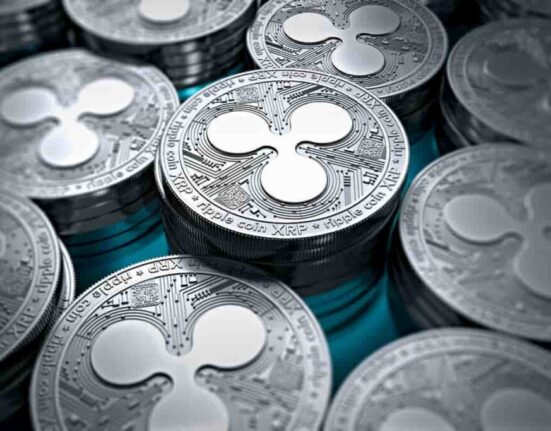Polygon MATIC is a “layer two” or “sidechain” scaling solution that runs alongside the Ethereum blockchain — allowing for speedy transactions and low fees. MATIC is the network’s native cryptocurrency, which is used for fees, staking, and more. You can buy or sell MATIC via exchanges like Coinbase.
The Ethereum blockchain is home to a vast range of economic activity — from NFT markets and games to the growing DeFi ecosystem. Ethereum is well suited to this activity because it’s compatible with smart contracts, which can be used to build a vast range of applications.
However, the growing popularity of these applications adds many transactions to the Ethereum blockchain — and as a result, transaction fees (also known as “gas”) can sometimes rise to the point where making small or frequent investments can be economically unviable.
Enter , which is a “Layer 2” scaling solution (or “sidechain”) that’s emerged to provide faster transactions and lower costs for users. It acts as a speedy parallel blockchain running alongside the main Ethereum blockchain. To use it, you can “bridge” some of your crypto over to Polygon, and then interact with a wide range of popular crypto apps that were once exclusive to the main Ethereum blockchain.
What is MATIC?
Polygon has its own cryptocurrency, called MATIC, which is used to pay fees on the Polygon network, for staking, and for governance (which means that MATIC holders get to vote on changes to Polygon). You can also buy and sell MATIC via Coinbase and other exchanges.
The name MATIC comes from an earlier stage in Polygon’s development. After launching as Matic Network in October 2017, developers rebranded as early in 2021.
MATIC is the native cryptocurrency of the Polygon network, a blockchain platform designed to address scalability and interoperability challenges faced by the Ethereum blockchain. Here’s a breakdown of MATIC’s role in the ecosystem:
Functionalities of MATIC:
- Transaction Fees: MATIC is the primary currency used to pay for transaction fees on the Polygon network. Users need MATIC to interact with decentralized applications (dApps), smart contracts, and other functionalities on .
- Staking: MATIC token holders can stake their tokens to contribute to the security of the Polygon network. In return, they can earn rewards in the form of additional MATIC tokens.
- Governance: MATIC holders have voting rights on proposals for the future development and upgrades of the Polygon network. This allows the community to participate in shaping the platform’s direction.
Benefits of Using MATIC:
- Faster and Cheaper Transactions: , powered by MATIC, offers significantly faster and cheaper transactions compared to the Ethereum blockchain, attracting users and developers seeking a more scalable solution.
- Security: leverages Ethereum’s security model for its main chain, while MATIC plays a role in securing the network through staking mechanisms.
- Interoperability: aims to be interoperable with other blockchains, allowing seamless transfer of assets and data between different ecosystems.
What is MATIC’s current price?
As of today, June 23, 2024, the live price of MATIC is around $0.57 USD (information accurate at the time of writing). It’s important to remember that cryptocurrency prices can fluctuate throughout the day. Here are some resources to track the current price of MATIC and other cryptocurrencies:
- CoinMarketCap
- CoinGecko
- Binance
- Coinbase
- CoinDataCap
These websites provide live price updates, charts, and market capitalization data for MATIC and many other cryptocurrencies.
How does Polygon work?
You can picture as being like an express train on a subway — it travels along the same route as the regular train, but it makes fewer stops and thus moves much faster. (In this analogy the main Ethereum blockchain is the local train.) Polygon uses a variety of technologies to create this speedy parallel blockchain and link it to the main Ethereum blockchain.
To create new MATIC and secure the network, Polygon uses a proof-of-stake consensus mechanism — which means that one way you earn money on MATIC you hold is via staking.
- Validators do the heavy lifting — they verify new transactions and add them to the blockchain. In exchange, they may receive a cut of fees and newly created MATIC. Becoming a validator is a commitment that requires running a full-time node (or computer) and staking your own MATIC. If you make an error or act maliciously (or even if your internet connection is glitchy) you could lose some of your staked MATIC.
- Delegators stake their MATIC indirectly via a trusted validator. This is a much lower-commitment version of staking. But it still requires research — if the validator you pick acts maliciously or makes errors you could lose some or all of your staked MATIC.
, powered by its MATIC token, works as a “layer two” scaling solution for the Ethereum blockchain. Here’s a breakdown of how it tackles Ethereum’s scalability challenges:
Ethereum’s Scalability Issues:
- Limited Throughput: The Ethereum blockchain can only process a limited number of transactions per second (TPS), leading to network congestion and high transaction fees.
- Slow Confirmation Times: Due to congestion, transactions on Ethereum can take a long time to be confirmed, impacting user experience.
Polygon’s Approach:
- Sidechains for Scalability: Polygon utilizes a network of sidechains running parallel to the Ethereum main chain. These sidechains can process transactions independently, significantly increasing the overall transaction throughput of the network.
- Proof-of-Stake for Efficiency: Unlike Ethereum’s Proof-of-Work (PoW) mechanism, Polygon utilizes Proof-of-Stake (PoS) for faster and more energy-efficient transaction validation on its sidechains.
Interaction Between Sidechains and Ethereum:
- Main Chain Security: While sidechains handle most transactions, relies on the Ethereum main chain for final settlement and security. This ensures that Polyon inherits Ethereum’s robust security measures.
- Bridges for Transfers: Users can move assets (like ETH tokens) between the Ethereum main chain and sidechains using bridges. These bridges act as gateways for interoperability.
Role of MATIC Token:
- Transaction Fees: Users pay MATIC tokens for gas fees when interacting with dApps and smart contracts on .
- Staking Rewards: MATIC holders can stake their tokens to secure the Polygon network and earn rewards in the form of additional MATIC tokens.
- Governance: MATIC holders have voting rights on proposals for the future development of the network.
Benefits of Polygon:
- Faster and Cheaper Transactions: By offloading processing to sidechains, Polygon offers significantly faster and cheaper transactions compared to the Ethereum main chain.
- Security: leverages Ethereum’s security for the main chain, while PoS on sidechains promotes efficiency.
- Scalability: The sidechain architecture allows Polygon to handle a much higher volume of transactions per second.
- Interoperability: aims to be interoperable with other blockchains, facilitating seamless asset and data transfer.
Overall, addresses Ethereum’s scalability limitations by providing a network of sidechains with faster transaction processing and lower fees. The MATIC token plays a crucial role in powering transactions, incentivizing network participation, and facilitating governance.
Here are some additional points to consider:
- Polygon is a relatively new project compared to Ethereum. Its long-term success depends on ongoing development, ecosystem growth, and wider adoption.
- As with any cryptocurrency, the value of MATIC can fluctuate.
It’s important to do your own research before investing in any cryptocurrency or blockchain project.
How do you use the Polygon network?
The Polygon network allows you to do many of the same things the main Ethereum network allows, but with fees that are often a fraction of a cent. You can try decentralized exchanges like QuikSwap or SushiSwap, yield-generating lending and savings protocols like Aave, NFT markets like OpenSea, or even “no-loss prize games” like Pooltogether.
To try the network, you need to send some crypto to a compatible crypto wallet like Coinbase Wallet. You can then “bridge” some of your crypto — stablecoins are a popular choice for this — to the Polygon network. You’ll also need to bridge some MATIC to make transactions, but even a dollar’s worth is plenty because fees are so low.
Low fees and near-instant transactions make the Polygon network an excellent way to gain some real-world experience trying out DeFi protocols. (Remember that DeFi can be highly volatile — so start small and don’t invest more than you can afford to lose, especially as a beginner.)
There are several ways you can interact with the Polygon network, depending on your goals. Here’s a breakdown of common use cases:
Using DeFi Applications (dApps) on Polygon:
- Choose a Polygon Wallet: You’ll need a crypto wallet compatible with Polygon to store MATIC tokens and interact with dApps. Popular options include MetaMask (with network switching enabled for Polygon), WalletConnect, and Trust Wallet.
- Fund Your Wallet with MATIC: Ensure you have MATIC tokens in your wallet to cover transaction fees on the Polygon network. You can acquire MATIC through cryptocurrency exchanges or transfer them from another wallet that supports Polygon.
- Connect to a Polygon dApp: Many DeFi applications have a “Connect Wallet” option. Follow the instructions to connect your Polygon-compatible wallet to the dApp.
- Interact with the dApp: Once connected, you can use the dApp’s functionalities, such as swapping tokens, providing liquidity, or participating in yield farming (depending on the specific dApp). Remember to pay transaction fees with MATIC.
Here are some resources to find Polygon dApps:
- Polygon dApp List: [invalid URL removed]
- DappRadar – Polygon Network: [invalid URL removed]
Transferring Assets Between Ethereum and Polygon:
- Use a Bridge: Polygon uses bridges to allow users to transfer assets between the Ethereum main chain and Polygon sidechains. Popular bridges include Multichain (formerly Anyswap) and Ren.
- Connect Your Wallet: Connect your wallet compatible with both Ethereum and Polygon to the chosen bridge.
- Select Assets and Network: Specify the asset you want to transfer (e.g., ETH, USDC) and choose the destination network (Ethereum or Polygon).
- Initiate Transfer and Approve Transaction: Follow the bridge’s instructions to initiate the transfer and approve the transaction in your wallet. This will involve paying gas fees on both the Ethereum and Polygon networks.
Staking MATIC:
- Choose a Staking Platform: Several platforms allow you to stake MATIC tokens and earn rewards. Research and choose a reputable platform with clear terms and conditions. Some options include delegator staking directly on Polygon wallets or through cryptocurrency exchanges offering staking services.
- Transfer MATIC to the Platform: Transfer the MATIC tokens you wish to stake to the chosen staking platform.
- Delegate or Stake Your Tokens: Follow the platform’s instructions to delegate or stake your MATIC tokens. This typically involves choosing a validator to support.
Remember:
- Before interacting with any dApp, bridge, or staking platform, conduct thorough research and ensure they are reputable and secure.
- Always be cautious when sharing your wallet details or private keys.
- Understand the potential risks involved, such as smart contract vulnerabilities and impermanent loss in DeFi.
By following these steps and exercising caution, you can explore the various functionalities offered by the Polygon network.
Disclaimer ||
The Information provided on this website article does not constitute investment advice,financial advice,trading advice,or any other sort of advice and you should not treat any of the website’s content as such.
Always do your own research! DYOR NFA
Coin Data Cap does not recommend that any cryptocurrency should be bought, sold or held by you, Do Conduct your own due diligence and consult your financial adviser before making any investment decisions!



